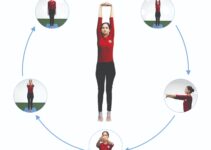Vrikshasana meaning
Vrikshasana is taken from the Sanskrit word Vrska ( वृक्षासन). It comprises two words: Vriksh, tree and asana, indicating a Yogic posture. If somebody pronounced Vrikshasana, it should be as vrik-shah-sana. While performing, it gives the true spirit of the tree, thus named the tree pose. “Stand erect on the left leg, bend the right leg and place the right foot on the root of the right thigh. Maintain the pose like a tree on the ground. This is called vriksha-asana” Gheranda-samhita II.36.

Breathing in Vrikshasana yoga
All the yoga poses should be performed with proper breathing techniques. The same things are applied to Vrikshasana. While in Tree pose, inhale and raise both arms above your head and form Namaskar mudra. Take suitable stretching and inhaling-exhaling continue while maintaining the pose. Bring your arms down with deep exhaling.
How to perform Vrikshasana Steps
How to make a tree pose technically correct is essential to get its maximum benefits? Here, step-by-step practising techniques are mentioned, especially for beginners to become masters of the carriage.
- Stand erect. Keep the feet together.
- Fold the right leg and place it at the top of the left thighs with the toes of the right leg pointing downwards.
- The right leg should be perpendicular to the left leg.
- Extend your arms above your head.
- Inhale and try to make Namaskar mudra with your palms.
- Balance the pose as long as possible because balancing is paramount in the Tree pose.
- Try to make your spine straight and feel the stretching from toes to fingers.
- With a deep exhale, bring your arms and legs down.
- Repeat the same with the left leg. It completes one round.
- Do three rounds.
- No. Of rounds may increase at your convenience.
Health benefits of Vrikshasana
- It stretches the entire body from toes to fingers, thus invigorating you.
- It gives tranquillity to your mind, thus suitable for those facing depression and anxiety.
- It increases your stamina, concentration, and immunity.
- It is suitable for your hips as it helps to open it.
- It is beneficial for those who are experiencing sciatica. However, one should practice it under the supervision of a yoga expert.
- It enhances the flexibility of the legs, back, and chest muscles.
- It makes your ankle stronger.
- It should be performed as knee yoga. The person who is having knee problems should perform it.
- It strengthens thighs and calves.
- It gives suitable stretching to the groins.
- People suffering from flat feet should practice it.
- It makes you more focused and concentrated.
- By practising this asana, the ligaments and tendons of the feet strengthen.
- It is also suitable for the pelvic region.
- It develops esteem and self-confidence.
- It calms and relaxes the central nervous system.
- It helps to cure rheumatic pain and also treats numbness.
Precautions
Some of this yoga pose’s essential contraindications, cautions, and side effects are given below.
It should not be practised in case of
- High blood pressure
- Low blood pressure
- Migraine
- Insomnia
- Acute knee problems
- Hip injury






It is very useful yoga
It was according to me what information i needed
Thanks gyanunlimited.com
Why these r called as asanas
Good content! Keep t up!
Useful…..Information
It is very helpful for health
Yoga is very good for our health . We must try to do it everyday.
Yoga is very beneficial for health..
Very helpful information!
‘Asana’ in Sankrit language is ‘Pose’ in English. Yoga asana, means Yoga poses, which are the ways to better an individual’s overall health (mental, physical, emotional and spiritual). Asana means seat/khursi in hindi, means the ‘Base”.